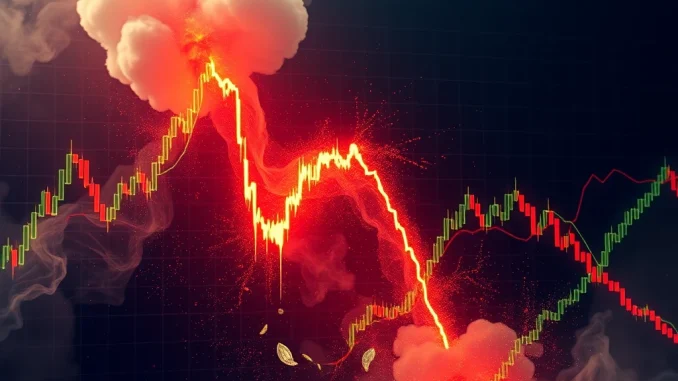
The cryptocurrency market has just witnessed a significant event, with a staggering $104 million worth of futures contracts liquidated in the past hour alone. This follows a volatile 24-hour period that saw total crypto liquidations reach an eye-watering $418 million across major exchanges. These numbers highlight the inherent risks and dramatic swings possible when trading with leverage in the crypto space.
What Are Crypto Liquidations and Why Do They Happen?
For those new to the world of derivatives, a liquidation occurs when a trader’s leveraged position is forcibly closed by an exchange. This happens because the trader’s margin balance falls below the minimum required level to keep the trade open. Essentially, the market has moved against their bet to such an extent that their initial capital (margin) is no longer sufficient to cover potential losses.
Think of it like borrowing money to make a bigger bet. If the bet goes wrong, the lender (the exchange) closes your position to prevent losing their own money. The bigger the leverage used, the smaller the price movement required to trigger a liquidation.
Understanding the Mechanics of Leveraged Trading
Crypto futures trading allows participants to speculate on the future price of cryptocurrencies without owning the underlying asset. Leverage amplifies both potential profits and losses. For example, with 10x leverage, a trader can control $10,000 worth of crypto with just $1,000 of their own capital. If the price moves 10% in their favor, they double their money (minus fees). But if it moves just 10% against them, their entire $1,000 margin is wiped out, leading to liquidation.
- Leverage: Borrowing funds to increase trading size.
- Margin: The trader’s own capital deposited to open and maintain a leveraged position.
- Margin Call: A warning that your margin is running low.
- Liquidation: The automatic closing of a position when margin falls too low, resulting in loss of the margin.
Analyzing the Recent $104M and $418M Wipeout
The rapid $104 million liquidation event within a single hour suggests a sharp, sudden price movement. This could have been a rapid pump or dump that caught many leveraged traders off guard. The larger $418 million figure over 24 hours indicates sustained pressure or multiple significant price swings.
While specific coin breakdowns vary, Bitcoin liquidations and Ethereum liquidations typically constitute the largest portions of these totals due to their high trading volumes and open interest in futures markets. A sudden move in BTC or ETH price can trigger a cascade effect across the market.
Why Does This Matter for the Market?
Large-scale liquidations can exacerbate price movements. When positions are liquidated, the exchange often sells the underlying asset (or buys it, depending on whether it was a long or short position) to close the trade. This forced selling (or buying) adds to the market pressure, potentially triggering more liquidations in a domino effect. This contributes significantly to overall market volatility.
The high volume of liquidations signals a few things:
- There is significant leveraged trading activity in the market.
- Recent price action was sharp enough to hit liquidation levels for many traders.
- Market conditions are currently risky for high-leverage positions.
Longs vs. Shorts: Who Got Hit?
Liquidations happen to both ‘long’ positions (bets that the price will go up) and ‘short’ positions (bets that the price will go down).
If the market saw a rapid price drop, primarily ‘long’ positions would be liquidated. If there was a sharp price increase, ‘short’ positions would be hit. The data on which side suffered most in this specific event would provide clues about the direction of the price move that caused the cascade.
Navigating the Risks of Leveraged Crypto Trading
The substantial leveraged trading volume and subsequent liquidations serve as a stark reminder of the potential pitfalls. While leverage can amplify gains, it equally amplifies losses, making positions highly susceptible to even minor market fluctuations.
Actionable Insights for Traders:
- Understand Leverage: Know exactly how much price movement your position can withstand before liquidation.
- Manage Risk: Use stop-loss orders to automatically close your position at a predetermined price before liquidation occurs.
- Use Lower Leverage: Higher leverage means higher risk. Consider using lower multiples, especially during periods of high market volatility.
- Don’t Overcommit: Only trade with capital you can afford to lose.
- Stay Informed: Keep track of market news and price trends that could impact your positions.
Conclusion: A Volatile Market Remains
The recent spate of crypto liquidations, totaling $104 million in an hour and $418 million in 24 hours, underscores the volatile nature of the cryptocurrency market, particularly for those engaged in leveraged futures trading. These events are not just abstract numbers; they represent significant capital losses for traders caught on the wrong side of rapid price swings. While crypto futures offer opportunities, the risks associated with leveraged trading, especially during periods of high market volatility, cannot be overstated. As the market continues to fluctuate, exercising caution, managing risk diligently, and understanding the mechanics of leverage are paramount for anyone participating in this high-stakes environment.



